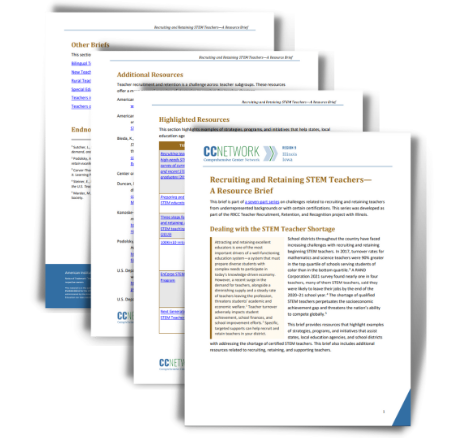Attracting and retaining excellent educators is one of the most important drivers of a well-functioning education system—a system that must prepare diverse students with complex needs to participate in today’s knowledge-driven economy. However, a recent surge in the demand for teachers, alongside a diminishing supply and a steady rate of teachers leaving the profession, threatens students’ academic and economic welfare. Teacher turnover adversely impacts student achievement, school finances, and school improvement efforts. Specific, targeted supports can help recruit and retain teachers in your district.
These seven briefs outline the most common challenges related to recruiting and retaining teachers from underrepresented backgrounds or with certain certifications in Illinois, though these challenges are common across the country.
This series was developed as part of the R9CC Teacher Recruitment, Retention, and Recognition project with the Illinois State Board of Education. To learn more about barriers to recruiting and retaining an effective and diverse teacher workforce read our summary of student focus groups and teacher interviews.
Across the United States, many districts find themselves short on bilingual teachers. More than half of the states face a shortage of such teachers, with shortages most acute in states that provide bilingual education to the greatest numbers of English learners. Bilingual and dual-language education have proven to have a positive effect on the achievement of both English learner and non-English learner students.
This brief provides resources that highlight examples of strategies, programs, and initiatives that help states, local education agencies, and school districts address the shortage of certified bilingual and second language teachers.
An estimated 17% to 30% of new teachers in the U.S. leave the profession within their first 5 years of teaching. Some challenges that prompt new teachers to leave the field include stress, lack of appropriate support, and feeling unprepared to handle behavioral and academic issues among their students. Research supports the finding that teachers who receive appropriate supports stay in the teaching field at rates more than twice those of teachers who lack these supports. However, only a small number of teachers have access to these supports.
This brief provides resources that highlight examples of strategies, programs, and initiatives that help states, local education agencies, and school districts address the shortage of newly certified teachers.
Rural school districts throughout the country face increasing challenges with recruiting and retaining beginning teachers due to job demands that include a lack of mentoring, lower salaries than their urban and suburban counterparts, geographic isolation, requirements to take on additional nonteaching duties, and teaching assignments that include multiple subjects and grade levels.
This brief provides resources that highlight examples of strategies, programs, and initiatives that assist states, local education agencies, and school districts with addressing the shortage of certified teachers who commit to teaching in rural school districts.
Teacher shortages disproportionally impact high need schools that can be hard to staff. However, effective teachers have an influential role in improving low-performing schools. Focusing on recruiting and retaining teachers to low-income and low-performing schools is crucial not only to closing achievement gaps, but also to ensuring that students in these schools have access to high-quality teachers.
This brief provides resources that highlight examples of strategies, programs, and initiatives that assist states, local education agencies, and school districts with addressing the shortage of certified teachers who commit to teaching in low-income and low performing districts.
Download Recruiting and Retaining Teachers in Low Income and Low-Performing Schools
School districts throughout the country have faced increasing challenges with recruiting and retaining beginning STEM teachers. In 2017, turnover rates for mathematics and science teachers were 90% greater in the top quartile of schools serving students of color than in the bottom quartile. A RAND Corporation 2021 survey found nearly one in four teachers, many of them STEM teachers, said they were likely to leave their jobs by the end of the 2020–21 school year. The shortage of qualified STEM teachers perpetuates the socioeconomic achievement gap and threatens the nation’s ability to compete globally.
This brief provides resources that highlight examples of strategies, programs, and initiatives that assist states, local education agencies, and school districts with addressing the shortage of certified STEM teachers.
Although the percentage of teachers of color in the workforce has grown significantly over the past 30 years, it still does not reflect the diversity of the national population or students. Teachers of color also have higher turnover rates than White teachers, highlighting the need for strategies to retain teachers of color as well as recruit more of them. All students, especially students of color, benefit from having teachers of color. These benefits range from increases in academic performance to improved social emotional and nonacademic measures.
This brief provides resources that highlight examples of strategies, programs, and initiatives that assist states, local education agencies, and school districts with addressing the shortage of teachers of color.
Special education teachers ensure equitable access to education for 7.2 million public school students with disabilities. According to the January 2022 results of the National Center for Education Statistics school survey, 45% of responding schools reported that special education was identified as the teaching area with the most vacancies.
This brief provides resources that highlight examples of strategies, programs, and initiatives that help states, local education agencies, and school districts address the shortage of certified special education teachers.
Download Recruiting and Retaining Special Education Teachers
